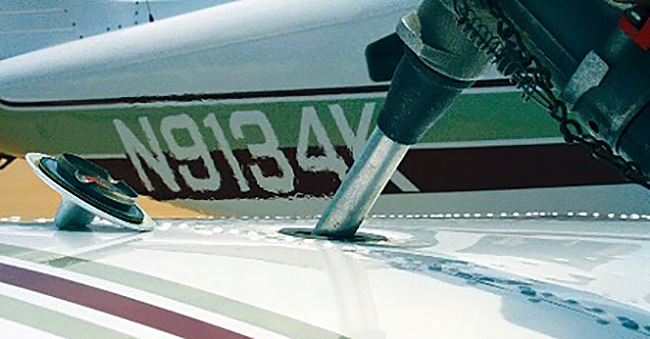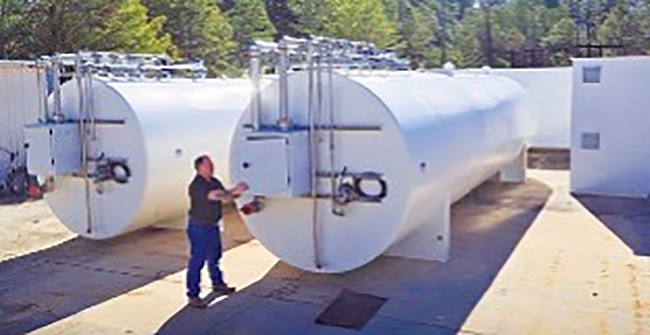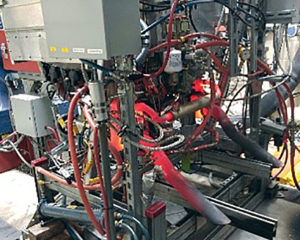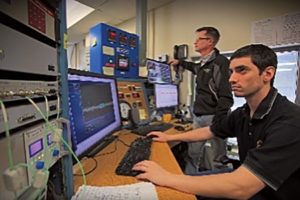Get the Lead Out! Looking at the Future of Avgas
By Paul Cianciolo, FAA Safety Briefing Associate Editor
There’s nothing better than the smell of avgas in the morning! Well, maybe the “sound of freedom” as a fighter jet soars by overhead may be better. Nevertheless, sampling aviation gas — avgas for short — is a ritual every general aviation pilot does during preflight. Part of the rationale is making sure you have the right grade of fuel, the one with the blue tinge. The other part is making sure there is no water in the tanks. Even though you may love that fuel smell, inhaling toxic lead particles is not the best decision for your health.

‘TEL’ Me More
Yes, lead. It’s the same lead you have to read about when you buy an old house or rent an apartment. Eating paint chips in today’s world may be a safer bet. (Please don’t eat paint chips.) Burning leaded fuel in piston-engine aircraft is one of the last remnants of 20th-century flight. Pumped at 3,000 airports across the country, avgas is the only remaining lead-containing transportation fuel.
The FAA shares the Environmental Protection Agency’s (EPA) concerns about lead emissions from small aircraft. More than 167,000 piston-engine aircraft operating in the United States rely on avgas. Lead is a toxic substance that can be inhaled or absorbed in the bloodstream, and emissions from avgas have become the largest contributor to the relatively low levels of lead emissions produced in this country.
There’s a reason for the lead in avgas, though. The additive used, tetraethyl lead (TEL) prevents damaging engine knock, or detonation, that can result in a sudden engine failure. The TEL byproducts after combustion also provide some benefits to exhaust valves by preventing them from recessing into the cylinder head and burning.

Searching for Alternates
Leaded gasoline for cars and trucks was fully phased out in 1996 with the passage of the Clean Air Act. At that time, piston-engine airplanes and helicopters were only responsible for around 5% of all emissions in the country. The advances in automobile engines created a new market for unleaded fuel, but there were no alternative fuels for piston engines.
The market for avgas is small, with jet fuel, which does not require lead, accounting for approximately 86% of aviation’s fuel needs. However, piston-engine aircraft are the staple of GA flying. Two-thirds of GA flying occurs for business purposes, which includes carrying millions of passengers annually, serving as the primary training ground for most commercial airline pilots, and aircraft used for firefighting, law enforcement, and search and rescue, among others. New aircraft just aren’t bought and sold like new vehicles, and no one wants to see an older piston engine aircraft lose value simply because it’s incompatible with a new avgas.
Given the drawbacks of lead, in 2013 the FAA and EPA launched a research and development program to find an alternative unleaded fuel for piston aircraft. To help “get the lead out,” the FAA is supporting the research of alternate fuels at its William J. Hughes Technical Center in Atlantic City. Through the Piston Aviation Fuels Initiative (PAFI), the FAA is working with aircraft and engine manufacturers, fuel producers, the EPA, and industry associations to overcome technical and logistical challenges to developing and deploying a new, unleaded fuel.
Knock, Knock!
The focus of the PAFI is qualification and authorization of an acceptable unleaded fuel and the safe transition to a more environmentally-friendly aviation fuel, which includes four key elements.
- Fleet-wide Authorization Qualification Test Program
- New Alternative Fuel Proposals and Certification
- Establishment of FAA Safety Standards
- Safe Deployment and Transition to a New Fuel
 Testing, which has been ongoing since late 2014, was recently delayed due to the COVID-19 public health emergency. The FAA, fuel suppliers, and aerospace manufacturers continue to develop high octane, unleaded fuel formulations. The FAA requires the fuel producers to complete pre-screening tests prior to a candidate fuel formulation entering into more extensive testing through the PAFI. These tests include completion of a 150 hour engine endurance test on a turbocharged engine, an engine detonation screening test, and material compatibility tests using the PAFI test protocols or other procedures coordinated with the FAA.
Testing, which has been ongoing since late 2014, was recently delayed due to the COVID-19 public health emergency. The FAA, fuel suppliers, and aerospace manufacturers continue to develop high octane, unleaded fuel formulations. The FAA requires the fuel producers to complete pre-screening tests prior to a candidate fuel formulation entering into more extensive testing through the PAFI. These tests include completion of a 150 hour engine endurance test on a turbocharged engine, an engine detonation screening test, and material compatibility tests using the PAFI test protocols or other procedures coordinated with the FAA.

Development and pre-screening testing is taking place at both private and public testing facilities across the country. The FAA’s William J. Hughes Technical Center is providing engine-testing services with individual fuel companies. The FAA also continues to support other fuel applicants who have decided to pursue engine and airframe approvals that would allow the use of their fuel formulations through traditional certification processes.
In the big scheme of things, avgas for our GA aircraft is a very small portion of our country’s fuel needs. This last remnant of the high-octane needs for our “arsenal of democracy” 75 years ago is still fueling our need to fly. It’s time to get the lead out for good.
Prop Wash
In the short-term, lead exposure at airports can be reduced by increasing the distance between run-up areas and public areas. If existing run-up areas typically cause propeller wash to be directed off airport property or into areas where the public can be exposed, an airport operator should consider shifting either the location or orientation of run-up activities to locations where the emissions can be better contained to non-public areas of the airport. In cases where it is not immediately feasible to reduce lead emissions, minimize the public’s outdoor air exposure to lead emissions by either shifting fences to increase the distance between run-up areas and public observation areas and/or posting signs to discourage loitering by the public in those areas where there may be potential and unnecessary exposure to lead from piston engine aircraft emissions.
With valuable input from industry, the FAA is taking important steps in advancing general aviation forward to a cleaner future. So next time you smell avgas in the morning, know that change is in the air.
Paul Cianciolo is an associate editor and the social media lead for FAA Safety Briefing. He is a U.S. Air Force veteran, and an auxiliary airman with Civil Air Patrol.
Reprinted with permission from FAA Safety Briefing. Visit the Flight Safety Briefing website: https://www.faa.gov/news/safety_briefing/



